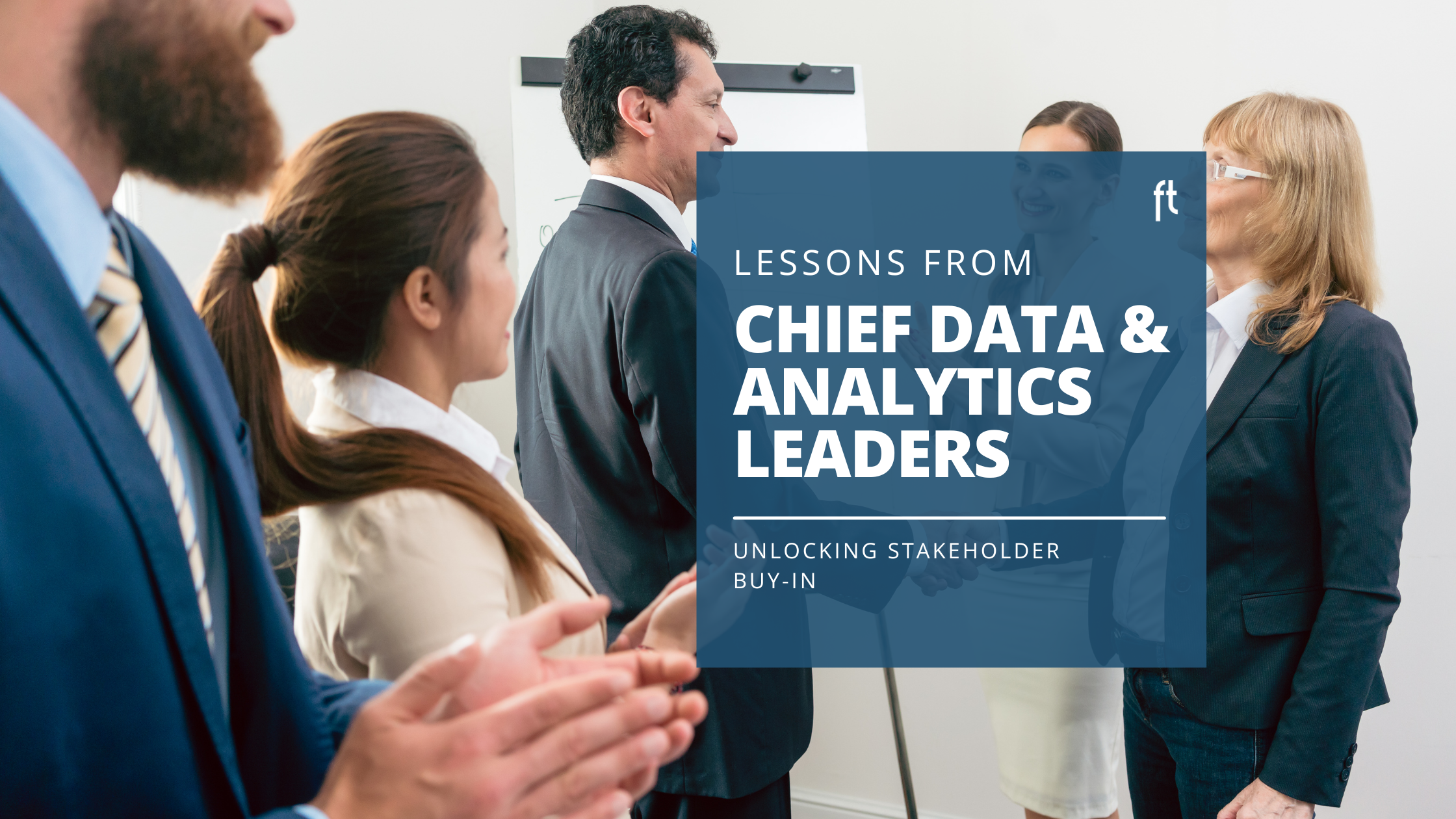Driving data initiatives isn’t just about technology. True transformation begins with people — the leaders, teams, and stakeholders who support and champion your vision. For Chief Data & Analytics Officers (CDAOs), securing genuine stakeholder buy-in is one of the biggest ongoing challenges in achieving measurable business impact.
At Frazer Tremble, we recently hosted a roundtable for CDAOs to explore this challenge in depth. Led by Laura Frazer, Managing Director, over 20 senior leaders engaged in a candid exchange of experiences, frustrations, and practical strategies that are working in today’s data-driven organisations.
Here are the most impactful insights from the session — essential reading for any data leader seeking to influence, inspire, and deliver value through data.
Understanding Change Fatigue: A Hidden Barrier
Many stakeholders are exhausted by constant “new platform” announcements, tools, or AI initiatives. Harvard Business Review calls this “transformation deficit”, the gap between required change effort and employee willingness, which can lead to fatigue and disengagement (HBR, 2022).
“We keep telling leaders this is the last platform they’ll need and then we pivot again. It erodes trust.”
Strategies to Address Change Fatigue:
Acknowledge the challenge openly.
Deliver incremental wins to build confidence.
Frame initiatives in today’s terms to show immediate impact.
Use plain language to connect with stakeholders’ concerns.
Sell the Problem, Not the Solution
Focus on the problem your stakeholders care about, rather than your preferred solution.
“Don’t ask for buy-in to your solution. Ask for buy-in to the problem I care about.”
Executives care about outcomes: risk mitigation, operational efficiency, and customer value. Reframing initiatives in this way increases engagement and accelerates adoption.
Example: Data Governance
Executives aren’t interested in frameworks for their own sake — they want to reduce exposure to regulatory and reputational risk. AWS highlights four pillars of effective data governance: visibility, access control, quality assurance, and ownership (AWS, 2024).
Tips for CDAOs:
Begin with business risk, not technical architecture.
Use real examples of inefficiencies or missed opportunities.
Let stakeholders feel the problem before offering a solution.
Linking Data Initiatives to Tangible Value
Even technically sound projects struggle without a clear value proposition.
“If I can’t tie a dollar value to a project, I don’t do it.”
Strategies:
Align initiatives with business priorities.
Categorise efforts into revenue opportunities, risk reduction, and compliance necessities.
Encourage co-ownership with a 70/30 partnership model:
“We do 70% of the work — build, test, operationalise. The business owns 30%: validating impact and championing outcomes.”
KPMG’s Voice of the CDAO report notes that collaboration between technical and business teams drives faster adoption and measurable results (KPMG, 2025).
Communicating Impact: The Language Matters
Delivering value isn’t enough — how you communicate it matters.
“People come to you with impossible problems and expect magic. You have to reset expectations without killing momentum.”
Effective Communication Practices:
Avoid jargon; use business- and customer-focused language.
Engage stakeholders early in defining problems and metrics.
Reframe from “here’s what we built” to “here’s what we solved.”
Build internal champions to advocate for impact.
From Data Teams to Trust Communities
CDAOs are evolving from data stewards to trust architects, managing privacy, security, and AI adoption.
“We stopped calling it a data community. We called it a trust community, bringing together data, privacy, security, and customer.”
Best Practices:
Establish shared governance across data, privacy, and security.
Tie AI policies to data sensitivity tiers.
Prioritise proactive communication over reactive compliance.
IBM emphasises that governance models must evolve to address new risks from generative AI (IBM, 2023).
Generative AI: Encouraging Responsible Exploration
Generative AI offers opportunity and risk. The group agreed: don’t block it, but guide it responsibly.
Best Practices:
Start with business-aligned AI applications.
Train teams and establish internal policies.
Embed safeguards before scaling.
Empower AI champions to guide responsible adoption.
Gartner predicts that by 2026, over 80% of enterprises will deploy generative AI in production, highlighting the need for robust governance (Gartner, 2025).
Self-Service Platforms: Balance Access and Control
Self-service platforms empower teams but require oversight.
“Self-service is great until someone misinterprets the data. Then it’s costly.”
Recommendations:
Provide accessible insights with analyst oversight.
Ensure data accuracy, consistency, and governance.
Offer training alongside tools.
Managing Too Much Buy-In
Some organisations face overwhelming demand for initiatives.
“Now we have too much buy-in. Prioritisation and expectation management have become our biggest challenges.”
Strategies:
Treat data as a platform-as-a-service with modular, reusable solutions.
Provide real-time, low-latency data.
Implement clear prioritisation frameworks.
The Evolving Role of the CDAO
CDAOs are becoming ecosystem integrators, connecting internal data with partners, vendors, and regulatory standards.
“We’re moving from owning the pipes to designing the ecosystem.”
They champion frameworks that balance delivery with ethical impact, aligning data strategy with business goals.
The CX/Data Alliance
Customer Experience (CX) and data leadership are increasingly converging.
“We’re seeing CX leaders wanting to build data teams from scratch. The functions are merging or at least converging.”
Implications:
Speak the language of customer outcomes.
Collaborate on journey mapping, personalisation, and insights.
Embed data capabilities in cross-functional teams.
Ethics: The Next Frontier
Ethical frameworks are essential for guiding responsible data initiatives.
“We’ve got delivery frameworks. We’ve got governance. But we’re missing ethical tools to guide value-based decisions.”
Leaders must ask not just can we? but should we? — especially in AI and governance.
Final Thought: Buy-In Starts With Belonging
“It’s not about getting buy-in for your solution. It’s about showing that you care about their problem.”
Trust drives buy-in. Sponsors, internal champions, and aligned leadership are essential.
“If your CEO isn’t sponsoring it, it’s not an enterprise initiative. It’s just a department project.”
The future belongs to leaders who connect, collaborate, and keep people at the centre of transformation.
CDAOs interested in future roundtables or peer discussions can connect with Laura Frazer at Frazer Tremble to join the conversation and gain ongoing insights into data leadership and stakeholder buy-in.
